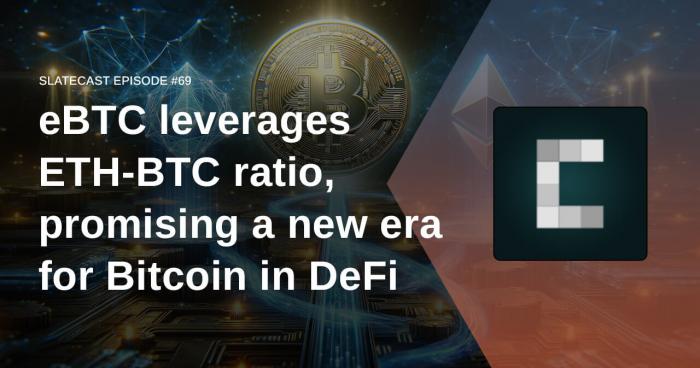In a recent episode of the SlateCast, Badger.com founder Spadaboom joined Senior Editor Liam “Akiba” Wright and CryptoSlate CEO Nate Whitehill to discuss the future of Bitcoin DeFi and the role of the ETH-BTC ratio in bridging the two worlds.
eBTC aims to create a decentralized and immutable representation of Bitcoin on Ethereum, allowing users to participate in DeFi applications while maintaining the core properties of Bitcoin.
The Origins of eBTC
Spadaboom has been a proponent of Bitcoin for over a decade, but he also became engaged in the Ethereum world since its early days. This led him to believe in duality versus tribalism, recognizing the value in both ecosystems. In 2019, he put his efforts into bringing utility to Bitcoin, allowing holders to earn yield and participate in financial activities beyond just holding. Spadaboom said:
“When I decided to put some pedal behind the metal, in 2019, it was really about how do you bring utility to Bitcoin? And at the time I felt like people with Bitcoin, like myself, and I’m sure you guys want to do shit with it. It’s as simple as that. They want to earn some yield.”
Ethereum’s Role in Bitcoin DeFi
While Spadaboom acknowledges the exciting developments happening on the Bitcoin network, he believes that Ethereum’s infrastructure and scaling capabilities make it an ideal platform for building a robust Bitcoin DeFi ecosystem.
He sees the 10 billion WBTC (Wrapped Bitcoin) sitting on Ethereum as evidence of the demand for a representation of Bitcoin that can be used in DeFi. Spadaboom explained:
“I still think there’s a pretty massive opportunity for people that want to use a representation of Bitcoin on other networks akin to the Euro dollar, right? If you think about it in those types of terms, and if you think about it like that, naturally That is driving demand for bitcoin, right?”
eBTC and the ETH-BTC Ratio
eBTC is designed to be the best way to borrow Bitcoin, offering low over-collateralization and no fees. Using Ethereum as collateral, users can borrow Bitcoin and leverage the ETH-BTC ratio up to 11 times. This capital-efficient approach, combined with the staking rewards from Ethereum, allows users to earn yield while holding a representation of Bitcoin.
“And for us, it’s because, EBTC spits out as like a Bitcoin peg stable coin against, it’s just the same concept, right?” Spadaboom said, referring to the leverage loop that allows users to increase their exposure to the ETH-BTC ratio.
The Future of Bitcoin DeFi
While acknowledging the risks and potential for losses in the emerging Bitcoin DeFi ecosystem, Spadaboom remains optimistic about the future.
He believes that by using foundational pieces of the Bitcoin stack, like data availability, and leveraging the existing infrastructure on Ethereum, a safer and more scalable Bitcoin DeFi ecosystem can be built. Spadaboom said:
“I do think that, my definition of building on Bitcoin or a layer two is something that uses foundational pieces of the the Bitcoin stack to ensure that, it can operate and has operational capacity, but that most likely will not that most likely will not mean that it has to be built on Bitcoin in the purest sense.”
As the appetite for development on Bitcoin continues to grow, Spadaboom sees opportunities for eBTC to expand and integrate with other protocols and layer 2 solutions. However, the focus currently lies strictly on the Ethereum mainnet. With the drive to create utility for Bitcoin and the potential for the ETH-BTC ratio to bridge the two ecosystems, the future of Bitcoin DeFi appears promising.
Watch the full podcast here:
NEW PODCAST
Does the ETH-BTC ratio offer a decentralized bridge for #Bitcoin DeFi and EVM interoperability?
Featuring @spadaboom1 of @BadgerDAO/@ebtcprotocol with co-hosts @akibablade and @NateWhitehill pic.twitter.com/uqivYULxzX
— CryptoSlate (@CryptoSlate) February 22, 2024
The post How eBTC leverages the ETH-BTC ratio, promising a new era for Bitcoin in DeFi appeared first on CryptoSlate.








